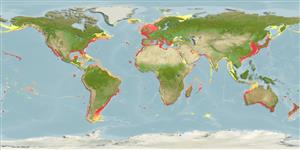Cephalopoda |
Octopoda |
Ocythoidae
Environment: milieu / climate zone / djupintervall / distribution range
Ekologi
Pelagiska; djupintervall 1 - 200 m (Ref. 110525). Subtropical
Northern and Southern Hemisphere. Subtropical to temperate.
Length at first maturity / Size / Weight / Age
Könsmognad: Lm ? range ? - ? cm Max length : 6.9 cm TL hane/ej könsbestämd; (Ref. 96968); 96 cm TL (female)
Female mantle length is 31 cm. Male mantle length is 3.0 cm (Ref. 96968). Maximum mantle length for females is 35 cm (Ref. 122360). Ocythoe are reported to be edible (Ref. 96968). Female Ocythoe sp. typically occupy near-surface waters, having been encountered in the upper 10 m and captured in plankton hauls and on hook and line. While male Ocythoe sp. have been collected in pelagic tows at the sea surface, they are not restricted to surface waters, having been collected in closing nets at 100 to 200 m. Species are reported to feed on pteropod and heteropod mollusks, sardines, and crustaceans (Ref. 96968).
Life cycle and mating behavior
Könsmognad | Reproduktion | Lek | Eggs | Fecundity | Larvae
Members of the class Cephalopoda are gonochoric. Male and female adults usually die shortly after spawning and brooding, respectively. Mating behavior: Males perform various displays to attract potential females for copulation. During copulation, male grasp the female and inserts the hectocotylus into the female's mantle cavity where fertilization usually occurs. Life cycle: Embryos hatch into planktonic stage and live for some time before they grow larger and take up a benthic existence as adults.
Cardoso, F. and C. Paredes 1998 La familia Ocythoidae (Cephalopoda: Octopoda) en el Perú. Revista Peruana de Biología. 5(2). Http://sisbib.unmsm.edu.pe/BVRevistas/biologia/v05_n2/ocythoid.htm. (Ref. 1979)
IUCN Red List Status
(Ref. 130435: Version 2025-1)
CITES status (Ref. 108899)
Not Evaluated
Not Evaluated
Threat to humans
Human uses
Fiskeri: saknar intresse
| FishSource |
Verktyg
Ytterligare information
Trophic EcologyFood items (preys)FödosammansättningFödointagPredatorer PhysiologySyreförbrukning
Human RelatedStamps, coins, misc.
Internet-källor
Estimates based on models
Fishing Vulnerability
High vulnerability (58 of 100).
Price category
Unknown.
